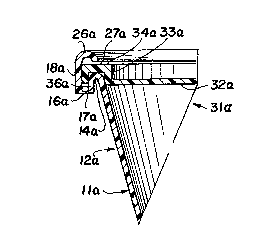Une partie des informations de ce site Web a été fournie par des sources externes. Le gouvernement du Canada n'assume aucune responsabilité concernant la précision, l'actualité ou la fiabilité des informations fournies par les sources externes. Les utilisateurs qui désirent employer cette information devraient consulter directement la source des informations. Le contenu fourni par les sources externes n'est pas assujetti aux exigences sur les langues officielles, la protection des renseignements personnels et l'accessibilité.
L'apparition de différences dans le texte et l'image des Revendications et de l'Abrégé dépend du moment auquel le document est publié. Les textes des Revendications et de l'Abrégé sont affichés :
| (12) Demande de brevet: | (11) CA 2075437 |
|---|---|
| (54) Titre français: | CONTENANT MUNI D'UNE BANDE INCURVEE INVIOLABLE SERVANT A LA FIXATION DU FERMOIR |
| (54) Titre anglais: | CONTAINER WITH CURLED TAMPER-EVIDENT BAND TO RETAIN CLOSURE |
| Statut: | Réputée abandonnée et au-delà du délai pour le rétablissement - en attente de la réponse à l’avis de communication rejetée |
| (51) Classification internationale des brevets (CIB): |
|
|---|---|
| (72) Inventeurs : |
|
| (73) Titulaires : |
|
| (71) Demandeurs : |
|
| (74) Agent: | SMART & BIGGAR LP |
| (74) Co-agent: | |
| (45) Délivré: | |
| (22) Date de dépôt: | 1992-08-06 |
| (41) Mise à la disponibilité du public: | 1993-02-08 |
| Licence disponible: | S.O. |
| Cédé au domaine public: | S.O. |
| (25) Langue des documents déposés: | Anglais |
| Traité de coopération en matière de brevets (PCT): | Non |
|---|
| (30) Données de priorité de la demande: | ||||||
|---|---|---|---|---|---|---|
|
ABSTRACT OF THE DISCLOSURE
A thin-walled, wide mouth molded plastic container is
provided with a tamper evident band initially molded as a
straight-walled cylinder spaced outwardly of the lip of the
container and connected thereto by a frangible horizontal
bridge. The upper edge of the cylindrical band extends above
the level of the container lip. Subsequent to molding and
preferably before capping, the band is curled inward by
application of a curling tool. The container lid is axially
applied, the outer edge of the lid displacing the curled band
outward. The resilience of the band and bridge permits outward
deflection and immediate restoration of the curl to its initial
position. The curl prevents removal of the lid without
fracture of the bridge and removal of the tamper-evident band.
Note : Les revendications sont présentées dans la langue officielle dans laquelle elles ont été soumises.
Note : Les descriptions sont présentées dans la langue officielle dans laquelle elles ont été soumises.

2024-08-01 : Dans le cadre de la transition vers les Brevets de nouvelle génération (BNG), la base de données sur les brevets canadiens (BDBC) contient désormais un Historique d'événement plus détaillé, qui reproduit le Journal des événements de notre nouvelle solution interne.
Veuillez noter que les événements débutant par « Inactive : » se réfèrent à des événements qui ne sont plus utilisés dans notre nouvelle solution interne.
Pour une meilleure compréhension de l'état de la demande ou brevet qui figure sur cette page, la rubrique Mise en garde , et les descriptions de Brevet , Historique d'événement , Taxes périodiques et Historique des paiements devraient être consultées.
| Description | Date |
|---|---|
| Inactive : CIB de MCD | 2006-03-11 |
| Le délai pour l'annulation est expiré | 1999-08-06 |
| Demande non rétablie avant l'échéance | 1999-08-06 |
| Réputée abandonnée - omission de répondre à un avis sur les taxes pour le maintien en état | 1998-08-06 |
| Demande publiée (accessible au public) | 1993-02-08 |
| Date d'abandonnement | Raison | Date de rétablissement |
|---|---|---|
| 1998-08-06 |
Le dernier paiement a été reçu le 1997-07-18
Avis : Si le paiement en totalité n'a pas été reçu au plus tard à la date indiquée, une taxe supplémentaire peut être imposée, soit une des taxes suivantes :
Les taxes sur les brevets sont ajustées au 1er janvier de chaque année. Les montants ci-dessus sont les montants actuels s'ils sont reçus au plus tard le 31 décembre de l'année en cours.
Veuillez vous référer à la page web des
taxes sur les brevets
de l'OPIC pour voir tous les montants actuels des taxes.
| Type de taxes | Anniversaire | Échéance | Date payée |
|---|---|---|---|
| TM (demande, 5e anniv.) - générale | 05 | 1997-08-06 | 1997-07-18 |
Les titulaires actuels et antérieures au dossier sont affichés en ordre alphabétique.
| Titulaires actuels au dossier |
|---|
| CAP SNAP CO. |
| Titulaires antérieures au dossier |
|---|
| DANIEL LUCH |
| RAWSON CHENAULT |